Since the rideshare service’s beginning, Uber has featured its drivers as a key element in its self-promotion. From the company’s website:
What makes the Uber experience truly great are the people behind the wheel. They are mothers and fathers. Students and teachers. Veterans. Neighbors. Friends. Our partners drive their own cars—on their own schedule—in cities big and small. Which is why more than one million people worldwide have signed up to drive.
As are those 1 million driving jobs, that driver-centric marketing meme is destined for the scrapheap of history. And sooner than you might think.
As reported in Bloomberg, Uber is hellbent on bringing driverless cars to the world’s byways and highways in the next five years. In addition to its own Advanced Technologies Center, whose primary focus is autonomous cars, Uber in July acquired Otto, a tech company formed to develop self-driving trucks. And Uber has a $300 million deal with Volvo to deliver a self-driving car by 2021.
The first fruits of these extensive design and engineering efforts will appear on the streets of Pittsburgh later this month, when riders will be ferried to their destinations in self-driving Volvo XC90 SUVs. For the time being, the driving will be “supervised” by a human sitting in the driver’s seat.
In a blog post on Uber’s website, company CEO Travis Kalanick makes the safety case for driverless cars, pointing out that 90 percent of the 1 million annual traffic fatalities are due to human error. “This is a tragedy that self-driving technology can help solve.”
That’s just one aspect, however, of a much more expansive vision, in which autonomous cars drive down the cost of local transportation so low that car ownership drastically declines. And everything that implies.
In the future, there will be no drivers, only riders.
Reader Reality Check
Are you ready for driverless cars?
After 20 years working in the travel industry, and almost that long writing about it, Tim Winship knows a thing or two about travel. Follow him on Twitter @twinship.
This article first appeared on SmarterTravel.com, where Tim is Editor-at-Large.


Leave a Reply